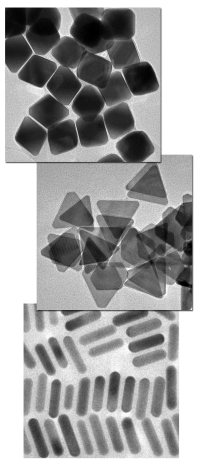DNA can do more than direct how bodies are made — it can also direct the composition of many kinds of materials, according to a new study from the U.S. Department of Energy’s Advanced Photon Source at Argonne.
Argonne researcher Byeongdu Lee and his colleagues at Northwestern University (NU) (principal investigator: Chad A. Mirkin, NU) discovered that strands of DNA can act as a kind of nanoscopic “Velcro’ that binds different nanoparticles together. “It’s generally difficult to precisely control the assembly of these types of nanostructures,” Lee said. “By using DNA, we’re borrowing nature’s power.”
The Velcro effect of the DNA is caused by the molecule’s “sticky ends,” which are regions of unpaired nucleotides—the building blocks of DNA—that are apt to bond chemically to their base-pair partners, just like in our genes. When sufficiently similar regions contact each other, chemical bonds form a rigid lattice. Scientists and engineers believe these complex nanostructures have the potential to form the basis of new plastics, electronics and fuels.
In 2008, Lee and his colleagues attached DNA to spherical nanoparticles made of gold, hoping to control the way the particles arrange themselves into compact, ordered crystals. This process is called nanoparticle packing, and Lee believed that by affixing DNA to the nanoparticles, he could control how they packed together. “Materials that are packed differently (even if they are made from the same substance have been shown to exhibit dramatically different physical and chemical properties,” Lee said.
While the 2008 experiment showed the DNA appeared to control that instance of nanosphere packing, it was not known whether the effect would occur with different nanoparticle geometries. The more recent experiment employed small-angle x-ray scattering at the DuPont-Northwestern-Dow Collaborative Access Team x-ray beamline located at Sector 5 of the APS Photon Source to study different shapes of nanoparticles and determine whether their contours affected how they packed.
According to Lee, the spherical nanoparticles in the earlier experiment tended to arrange themselves into one of two separate types of cubic crystals: a face-centered cube (a simple cube with nanospheres at each vertex and additional ones located in the middle of each face) or a body-centered cube (a simple cube with an additional nanosphere located in the middle of the cube itself). The type of lattice that the nanoparticles formed was determined by how the "sticky ends" attached to the nanoparticles paired together.
In the more recent experiment, the particles' shape did change the material's final structure, but only insofar as it altered how the DNA sticky ends attached to each other. In fact, the study showed that dodecahedral (12-sided) nanoparticles arranged into a face-centered cubic configuration while octahedral (8-sided) nanoparticles formed body-centered cubes, even when the nanoparticles were attached to identical strands of DNA. “We may be able to make all different types of nanoparticle packing structures, but the structure that will result will always be the one that maximizes the amount of binding,” Lee said. “The face-centered cubic structure is the most compact way for the nanoparticles to arrange themselves, while the body-centered cubic is slightly less compact. The DNA binding is really the true force controlling the construction of the lattice.”
See: Matthew R. Jones1, Robert J. Macfarlane1, Byeongdu Lee2, Jian Zhang1, Kaylie L. Young1, Andrew J. Senesi1, and Chad A. Mirkin1*, “DNA-nanoparticle superlattices formed from anisotropic building blocks,” Nat. Mater. 9, 913 ( November 2010). DOI:10.1038/NMAT2870
Author affiliations: 1Northwestern University, 2Argonne National Laboratory
Correspondence: *[email protected]
C.A.M. acknowledges the National Science Foundation (NSF)-Nanoscale Science and Engineering Center and the Air Force Office of Scientific Research for grant support, and the U.S. Department of Energy (DOE) Office (Award No. DE-SC0000989) for support through the Northwestern University Nonequilibrium Energy Research Center. He is also grateful for an National Security Science and Engineering Faculty Fellowship from the Department of Defense. M.R.J. acknowledges Northwestern University for a Ryan Fellowship and the NSF for a Graduate Research Fellowship. R.J.M. acknowledges Northwestern University for a Ryan Fellowship. K.L.Y. acknowledges the NSF and the National Defense Science and Engineering Graduate Fellowship program for Graduate Research Fellowships. The DuPont-Northwestern-Dow Collaborative Access Team is supported by E.I. DuPont de Nemours & Co., The Dow Chemical Company, and the State of Illinois. Use of the APS at Argonne was supported by the U.S. Department of Energy, Office of Science, Office of Basic Energy Sciences, under Contract No. DE-AC02-06CH11357.
The original Argonne press release can be found here.
The Advanced Photon Source is an Office of Science User Facility operated for the U.S. Department of Energy (DOE) Office of Science by Argonne National Laboratory. The APS is the source of the Western Hemisphere’s brightest high-energy x-ray beams for research in virtually every scientific discipline. More than 3,500 scientists representing universities, industry, and academic institutions from every U.S. state and several foreign nations visit the APS each year to carry out applied and basic research in support of the DOE mission to understand, predict, and ultimately control matter and energy at the electronic, atomic, and molecular levels in order to provide the foundations for new energy technologies and to support DOE missions in energy, environment, and national security. To learn more about DOE x-ray user facilities.
Argonne National Laboratory seeks solutions to pressing national problems in science and technology. The nation's first national laboratory, Argonne conducts leading-edge basic and applied scientific research in virtually every scientific discipline. Argonne researchers work closely with researchers from hundreds of companies, universities, and federal, state and municipal agencies to help them solve their specific problems, advance America's scientific leadership and prepare the nation for a better future. With employees from more than 60 nations, Argonne is managed by UChicago Argonne, LLC for the U.S. Department of Energy's Office of Science.

